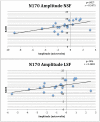Aberrant early visual neural activity and brain-behavior relationships in anorexia nervosa and body dysmorphic disorder
- PMID: 26082703
- PMCID: PMC4451358
- DOI: 10.3389/fnhum.2015.00301
Aberrant early visual neural activity and brain-behavior relationships in anorexia nervosa and body dysmorphic disorder
Abstract
Background: Body dysmorphic disorder (BDD) and anorexia nervosa (AN) share the clinical symptom of disturbed body image, which may be a function of perceptual distortions. Previous studies suggest visual or visuospatial processing abnormalities may be contributory, but have been unable to discern whether these occur early or late in the visual processing stream. We used electroencephalography (EEG) and visual event related potentials (ERP) to investigate early perceptual neural activity associated with processing visual stimuli.
Methods: We performed EEG on 20 AN, 20 BDD, 20 healthy controls, all unmedicated. In order to probe configural/holistic and detailed processing, participants viewed photographs of faces and houses that were unaltered or filtered to low or high spatial frequencies, respectively. We calculated the early ERP components P100 and N170, and compared amplitudes and latencies among groups.
Results: P100 amplitudes were smaller in AN than BDD and healthy controls, regardless of spatial frequency or stimulus type (faces or houses). Similarly, N170 latencies were longer in AN than healthy controls, regardless of spatial frequency or stimulus type, with a similar pattern in BDD at trend level significance. N170 amplitudes were smaller in AN than controls for high and normal spatial frequency images, and smaller in BDD than controls for normal spatial frequency images, regardless of stimulus type. Poor insight correlated with lower N170 amplitudes for normal and low spatial frequency faces in the BDD group.
Conclusions: Individuals with AN exhibit abnormal early visual system activity, consistent with reduced configural processing and enhanced detailed processing. This is evident regardless of whether the stimuli are appearance-or non-appearance-related, and thus may be a reflection of general, early perceptual abnormalities. As N170 amplitude could be a marker of structural encoding of faces, lower values may be associated with perceptual distortions and could contribute to poor insight in BDD. Future studies may explore visual ERP measures as potential biomarkers of illness phenotype.
Keywords: anorexia nervosa; body dysmorphic disorder; dorsal ventral streams; electroencephalography; visual processing.
Figures






Similar articles
-
Anorexia nervosa and body dysmorphic disorder are associated with abnormalities in processing visual information.Psychol Med. 2015 Jul;45(10):2111-22. doi: 10.1017/S0033291715000045. Epub 2015 Feb 5. Psychol Med. 2015. PMID: 25652023 Free PMC article.
-
Neural Correlates of Own- and Other-Face Perception in Body Dysmorphic Disorder.Front Psychiatry. 2020 Apr 24;11:302. doi: 10.3389/fpsyt.2020.00302. eCollection 2020. Front Psychiatry. 2020. PMID: 32395110 Free PMC article.
-
Visual information processing of faces in body dysmorphic disorder.Arch Gen Psychiatry. 2007 Dec;64(12):1417-25. doi: 10.1001/archpsyc.64.12.1417. Arch Gen Psychiatry. 2007. PMID: 18056550
-
Visual processing in anorexia nervosa and body dysmorphic disorder: similarities, differences, and future research directions.J Psychiatr Res. 2013 Oct;47(10):1483-91. doi: 10.1016/j.jpsychires.2013.06.003. Epub 2013 Jun 27. J Psychiatr Res. 2013. PMID: 23810196 Free PMC article. Review.
-
A hierarchy of visual processing deficits in body dysmorphic disorder: a conceptual review and empirical investigation.Cogn Neuropsychiatry. 2024 Mar;29(2):116-140. doi: 10.1080/13546805.2024.2326243. Epub 2024 Apr 2. Cogn Neuropsychiatry. 2024. PMID: 38563811 Review.
Cited by
-
Effects of visual attention modulation on dynamic functional connectivity during own-face viewing in body dysmorphic disorder.Neuropsychopharmacology. 2021 Oct;46(11):2030-2038. doi: 10.1038/s41386-021-01039-w. Epub 2021 May 28. Neuropsychopharmacology. 2021. PMID: 34050267 Free PMC article.
-
Increased early motivational response to food in adolescent anorexia nervosa revealed by magnetoencephalography.Psychol Med. 2021 May 5;52(16):1-9. doi: 10.1017/S003329172100088X. Online ahead of print. Psychol Med. 2021. PMID: 33947486 Free PMC article.
-
Neural and behavioral effects of modification of visual attention in body dysmorphic disorder.Transl Psychiatry. 2022 Aug 10;12(1):325. doi: 10.1038/s41398-022-02099-2. Transl Psychiatry. 2022. PMID: 35948537 Free PMC article.
-
Appearance evaluation of others' faces and bodies in anorexia nervosa and body dysmorphic disorder.Int J Eat Disord. 2017 Feb;50(2):127-138. doi: 10.1002/eat.22604. Epub 2016 Aug 27. Int J Eat Disord. 2017. PMID: 27566987 Free PMC article.
-
Visual training program for body dysmorphic disorder: protocol for a novel intervention pilot and feasibility trial.Pilot Feasibility Stud. 2018 Dec 21;4:189. doi: 10.1186/s40814-018-0384-3. eCollection 2018. Pilot Feasibility Stud. 2018. PMID: 30598835 Free PMC article.
References
-
- American Psychiatric Association. (2013). Diagnostic and Statistical Manual of Mental Disorders DSM-5. 5th Edn (Washington, DC: American Psychiatric Publishing; ). 10.1176/appi.books.9780890425596.744053 - DOI
-
- Bartlett J., Searcy J., Abdi H. (2003). What are the routes to face recognition?, in Perception of Faces, Objects, and Scenes: Analytic and Holistic Processes, eds Peterson M. A., Rhodes G. (Oxford: Oxford University Press; ), 21–52.
Grants and funding
LinkOut - more resources
Full Text Sources
Other Literature Sources
Research Materials

